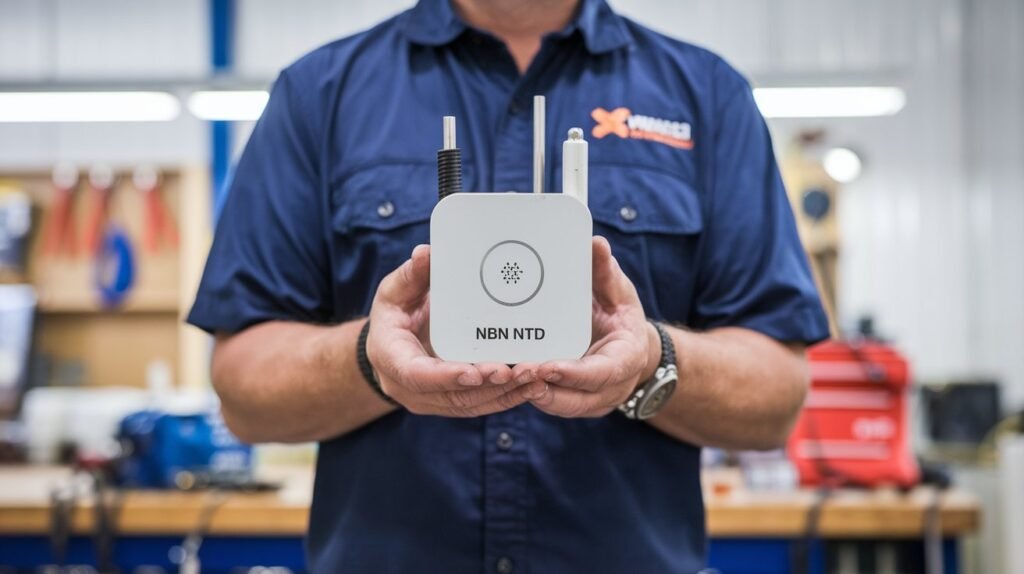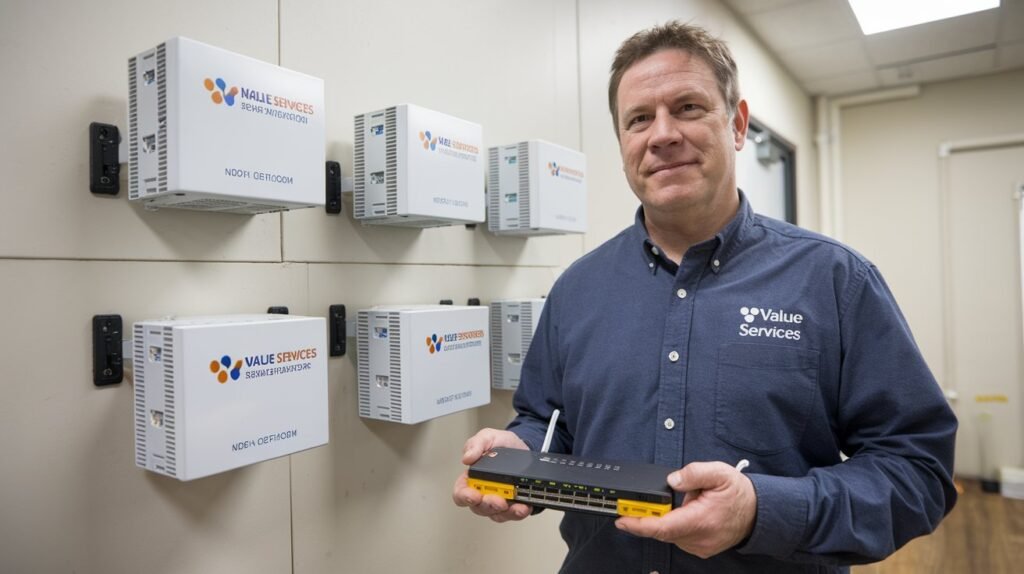This provides access to very high-speed Internet around the country of Australia as a whole. At the core of most NBN configurations lies NBN Network Termination Device, or in short- NBN NTD. So what actually is an NBN NTD, and why should it even matter? All that information about the NBN NTD will be provided.

Table of Contents
What Is an NBN NTD?
The NBN NTD is the device installed within your home that links you up to the various technologies of NBN, including the FTTP (fibre-to-the-premises) technology. It is then through this device that the connection is established between the internal router and computers to the NBN network. Think of it as the gateway from your premises into all the high-speed digital services offered by the NBN.
Key Features of the NBN NTD
- Multiple Ports
Typically, the NTD includes a number of ports, such as:- Data Ports: for internet services, enabling numerous connections or service providers.
- Voice Ports: for landline phone services using the NBN network.
These ports increase flexibility and support for several devices or services.
- Power Supply Unit (PSU)
- The NTD connects to a dedicated Power Supply Unit (PSU)
- Most times, the PSU has a battery backup that keeps your internet and voice service during a power failure to maintain connection during crucial situations.
- Technology-Specific Design
- The configuration of the NTD varies according to the type of NBN connection available at the location.
- For instance:
- FTTP: It will require a full installation of NTD.
- Other NBN technologies such as FTTN do not require the presence of an NTD connected within it because it will only require a router modem.
Thus, the design confines all activities to that with specific reference to the technology and the premises.
How Does the NBN NTD Work?
Estate NTD acts as this intermediary device in-between the national broadband network and the establishment’s devices. Here, find a short explanation of the working conditions through which this occurs: 1) How the NBN NTD Works.
How the NBN NTD Works
- Signal Reception
- An external NBN network infrastructure receives all incoming data signals into the NTD house. It includes signals coming from fiber optic cables for FTTP connections or from wireless signals for Fixed Wireless connections.
- Thus, the signal connects the household to an extensive NBN network, which transports internet and other services into the household.
- Signal Conversion
- The NTD then converts the data signal incoming into a format that would be in use by the common networking devices, such as modems or routers.
- This is because the data signal from NBN isn’t ending up in a form that can go through devices in the house.
- Device Connectivity
- Once converted, the NTD would then send the output to your modem or router via data ports through Ethernet cable connections.
- From here, you’d have internet service distributed to devices either through wired connections (Ethernet) or even wirelessly (Wi-Fi).

Do You Need an NBN NTD?
You require an NBN Network Termination Device (NTD) on the basis of what type of NBN connection has been provided to your property. Here’s a closer look into it
When Do You Need an NBN NTD?
- Fibre-to-the-Premises (FTTP)
- An NTD in this case becomes mandatory.
- It is installed as part of the fit out and will be the point of interface taking the NBN fibre cable to your internal devices.
- Without the NTD, the fibre connection will not provide anything inside your house or business, with regard to usable internet or voice services.
- Fixed Wireless
- This will also work for Fixed wireless.
- With this format, it will convert the wireless signal, which is received by the NBN towers, into a usable format for any individual devices connected to it.
- An outdoor antenna works with the device; that is, when each of them is connected with one another, the NTD will consume the wireless signal from that antenna.
When Is an NBN NTD Not Required?
Most other NBN connection types are such that the NTD is washed because the modem/router delivers the termination. This would include:
- Fibre-to-the-Node (FTTN)
- The phone line is made use of in FTTN configuration scenarios to deliver internet from the NBN infrastructure to your premises.
- You would connect a VDSL2-compatible modem/router directly to the wall socket, so no NTD would be necessary.
- Hybrid Fibre Coaxial (HFC)
- HFC connections are different. In this case, termination is handled by a cable modem from NBN Co rather than a NTD.
- This modem links up with the existing coaxial cable infrastructure for the NBN network.
- Fibre-to-the-Curb (FTTC)
- FTTC makes use of an NCD (Network Connection Device) as opposed to the NTD as a similar approach. The NCD connects on existing copper phone lines and provides internet access.
Common Questions About the NBN NTD
1. What Happens if My NBN NTD Is Faulty?
If your NBN NTD stops working, it’s essential to contact your internet provider. A faulty device can disrupt your entire connection.
2. Can I Move My NBN NTD?
No, the NTD must remain in its installed location. Relocating it requires professional assistance and approval from NBN Co.
3. Does Every Home Need an NBN NTD?
No, only specific connection types, such as FTTP and Fixed Wireless, require an NTD.

Troubleshooting NBN NTD Issues
If you are having trouble connecting, your NBN network termination device (NTD) troubleshooting can help clear up any common problems that may not actually require the help of an NBN technician. Here’s the expanded explanation of all the steps above:
Troubleshooting Steps for NBN NTD Issues
- Check the Indicator Lights
- Why It Matters: Almost all NTDs have status lights, which can be used to deduce the current operational state of the device (e.g., power, connection, and data activity).
- What to Do:
- Look for the lights present on the NTD.
- Check the user manual or search online to interpret that particular condition in which they react (e.g., green meaning normal operation, red for errors).
- Common Issues Indicated by Lights:
- No Power Light: The device is not receiving any power; check the power supply.
- No Connection Light: There may be a problem with the outside NBN network.
- Restart the Device (Power Cycle)
- Why It Matters: Restarting the NTD clears temporary glitches in its operation.
- What to Do:
- Turn off the power to the NTD and unplug it from the power source.
- Wait for about 30 seconds, then plug it back in and turn it on.
- Check if the problem persists after rebooting.
- Inspect the Cables
- Why It Matters: Loose or broken cable connections impede connections either between the NTD, modem/router, or the NBN infrastructure itself.
- What to Do:
- Check that all cables (power, ethernet, and fiber) are securely plugged into the right ports.
- Search for the obvious damage like broken wires or bent connectors.
- Replace any damaged cables with a new one.
- Contact Your Internet Provider
- Why It Matters: The steps mentioned above have not solved the problem. If a case exists, the cause may be external-a network outage in the NBN or hardware fault.
- What to Do:
- Contact Technical Support from your Internet Provider.
- Clearly state the problem, indicating any error lights or symptoms you have observed.
- Your provider may perform remote diagnostics or escalate the issue to NBN Co if necessary.
NBN NTD Installation Process
The steps involved in enhancing your connections to the NBN through NBN Network Termination Device installment are exceedingly simple but vital. Here’s an elaboration on those steps:
NBN NTD Installation Process
- Site Visit
- What Happens:
- An authorized NBN technician comes to your location and performs installation work.
- Normally, there is scheduling of this visit through your Internet service provider.
- Why It Matters:
- The technician will then inspect the external walls of your property to finalize the site best suited for installation of your NTD and connected to external NBN networks.
- What Happens:
- Device Placement
- What Happens:
- The technician finalizes the position where the NTD will sit. He will factor in:
- Proximity to where you plan to set up your modem/router.
- Accessibility to power outlet.
- Minimizing between various cables while maximizing signal efficiency.
- It would actually be an interior wall for FTTP and would work with an outdoors antenna for Fixed Wireless.
- The technician finalizes the position where the NTD will sit. He will factor in:
- Why It Matters:
- Establishes optimal performance, as well as ease of access to maintenance or troubleshooting.
- What Happens:
- Connection Setup
- What Happens:
- The technician then creates the mean NTD; to the external NBN infrastructure (for instance, fiber optic cable for FTTP or antenna for Fixed Wireless)
- Then plugs it into mains power a few minutes later and proves functionality.
- Testing basically involves checking if the indicator lights are showing the expected status and whether the NTD can communicate with the NBN.
- Why It Matters:
- This is to ensure that your NTD operates well and is set for taking calls and internet usage.
- What Happens:
People Also Ask: Related NBN NTD Questions
How long does the battery backup last? The backup typically provides power for 3-5 hours.
What is the difference between an NTD and a modem? The NTD connects to the NBN network, while the modem connects to your devices within the home.
Can I buy my own NTD? No, the NTD is provided by NBN Co as part of the installation.

Final Words: Making the Most of Your NBN Experience
Understanding the role of the NBN NTD is vital to fully enjoying the internet experience. Whether you’re installing a new connection or trying to troubleshoot problems, being aware of the workings of its parts will put you in a better position to make informed decisions. Ready to make the most of your NBN setup? Visit Value Services today for expert advice and support.

